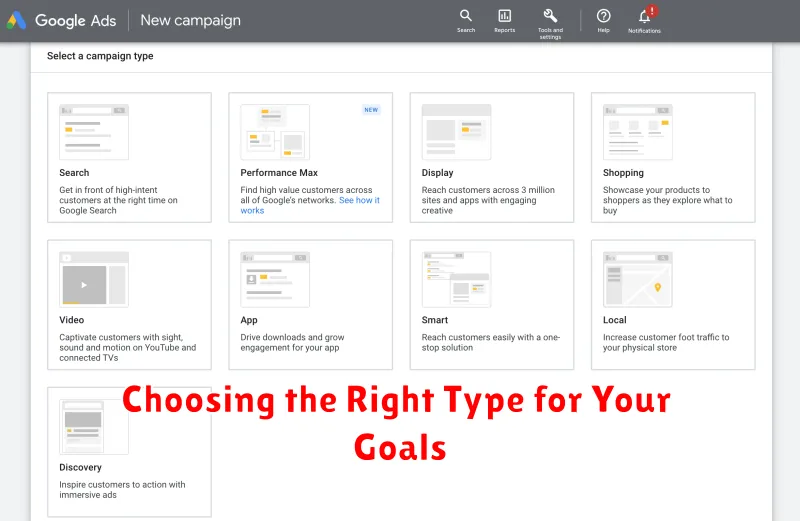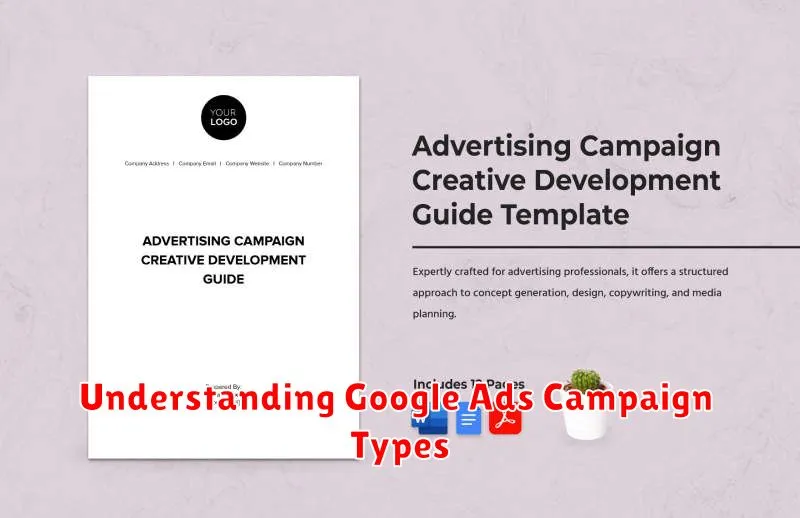Navigating the world of online advertising can be daunting. Google Ads presents a powerful platform for reaching potential customers, but understanding the various Google Ads campaign types is crucial for success. Choosing the right campaign type is the foundation of a successful Google Ads strategy. Whether your goal is to drive website traffic, generate leads, increase sales, or promote your brand, selecting the appropriate Google Ads campaign type will significantly impact your return on investment. This article will delve into the nuances of each Google Ads campaign type, empowering you to make informed decisions and optimize your advertising efforts.
From Search campaigns that capture users actively searching for your products or services, to Display campaigns that broaden your reach across the vast Google Display Network, and Shopping campaigns that showcase your products directly to potential buyers, the options are diverse and tailored to specific marketing objectives. Understanding the strengths and ideal use cases of each Google Ads campaign type, including Video campaigns, App campaigns, and Performance Max campaigns, is paramount. This comprehensive guide will equip you with the knowledge to select the Google Ads campaign types best suited for your business goals and target audience.
Overview of Google Ads Ecosystem
The Google Ads ecosystem is a complex network designed to connect businesses with potential customers across various Google platforms. It primarily operates on a pay-per-click (PPC) advertising model, meaning advertisers pay only when a user interacts with their ad.
This ecosystem encompasses several key components, including the Search Network where text ads appear alongside search results, the Display Network, a vast collection of websites showcasing visual ads, and YouTube, enabling video advertising to reach engaged audiences. Shopping campaigns allow retailers to promote products directly within search results, while App campaigns focus on driving app installations and engagement.
Search vs Display vs Video Campaigns
Choosing the right Google Ads campaign type is crucial for success. This section compares Search, Display, and Video campaigns, highlighting their strengths and ideal use cases.
Search campaigns target users actively searching specific keywords on Google. They are highly effective for driving conversions and reaching users with immediate purchase intent.
Display campaigns reach users browsing websites and apps across the Google Display Network. They are ideal for building brand awareness and retargeting potential customers.
Video campaigns run on YouTube and partner sites, engaging users with video content. They are best suited for building brand engagement and increasing product consideration.
Choosing the Right Type for Your Goals

Selecting the appropriate Google Ads campaign type is crucial for maximizing your return on investment (ROI). Each type serves a distinct purpose and aligns with specific marketing objectives. Consider your goals carefully before launching a campaign.
Are you aiming to drive website traffic and generate leads? Perhaps a Search campaign is the right fit. Looking to increase brand awareness and reach a broader audience? A Display campaign might be more effective. For businesses focused on driving online sales or promoting specific products, a Shopping campaign can deliver strong results. Finally, if your goal is to boost app installations and engagement, an App campaign is the optimal choice.
How to Optimize for Clicks and Conversions
Optimizing your Google Ads campaigns for both clicks and conversions is crucial for maximizing your return on investment (ROI). Clicks indicate user interest, while conversions represent the achievement of your campaign goals, whether that’s a purchase, signup, or another desired action.
Key optimization strategies include:
- Refining keywords: Use highly relevant keywords that precisely match user search intent.
- Improving ad copy: Craft compelling and clear ad copy that highlights your unique selling propositions and includes a strong call to action.
- Optimizing landing pages: Ensure your landing pages provide a seamless user experience and are relevant to the ad copy and keywords.
- A/B testing: Experiment with different ad variations and landing page designs to identify what resonates best with your target audience.
- Conversion tracking: Implement conversion tracking to measure the effectiveness of your campaigns and identify areas for improvement.
Tracking and Improving Performance
Tracking campaign performance is crucial for maximizing your return on investment. Google Ads provides robust tracking tools that allow you to monitor key metrics such as clicks, impressions, conversions, and cost-per-click (CPC). By analyzing this data, you can identify areas for improvement and optimize your campaigns for better results.
Several strategies can be employed to improve performance. Regularly reviewing and adjusting your keywords, bids, and ad copy is essential. A/B testing different ad variations helps determine what resonates best with your target audience. Furthermore, leveraging Google Ads’ targeting options, such as demographics, location, and interests, allows you to reach the most relevant users.

